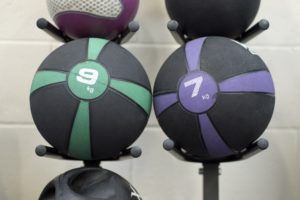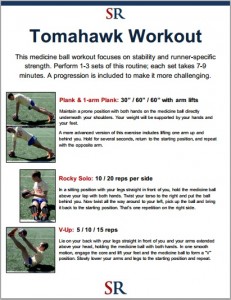What if you could run more – while feeling stronger and getting far fewer injuries?
I think you can.
If runners made just a few small changes to their training (we’ll show you how with this medicine ball workout) they’d see dramatic results with their running – and so many other areas of life.
Healthy running makes everything else seem easy, like climbing a few flights of stairs or keeping up with your kids. And the confidence you get from knowing you can attack your training plan with ease? Unparalleled.
But healthy running can’t happen unless you build the proper foundation to run consistently. Sadly, staying healthy can be a challenge for runners. It’s estimated that every year, anywhere from 65-80% of runners get injured.
Because running is a high impact sport that only emphasizes movement in one plane of motion, it’s not enough to make you a well-rounded athlete. And without a base of foundational strength and fitness, you’re far more likely to get injured.
Today I want to help you prevent more injuries by introducing a new medicine ball workout called the Tomahawk Medicine Ball Workout. All of the routines in Injury Prevention for Runners are named after medieval weapons so I’m continuing that tradition.
Medicine balls have been around in varying forms for thousands of years, and they were even used by Roman Gladiators during medieval times to prepare themselves for battle. So naming this routine after a medieval weapon is exceptionally fitting!
Benefits of Medicine Ball Exercises
Tomahawk is a more advanced routine that includes – you guessed it – medicine ball exercises. But why a dedicated medicine ball workout?
Once you start doing a comprehensive core routine and a more difficult hip strength routine, the next logical step is to incorporate medicine ball exercises into your strength program.
Medicine balls are versatile strength implements and can be used as a bridge between body-weight exercises and lifting weights at the gym. They’re inexpensive and incredibly convenient since they can be used in the privacy of your own home. Because they’re relatively lightweight, any runner can use them and you don’t need specialized knowledge or skills.
In addition to bridging the gap between bodyweight routines and heavier weights at the gym, medicine balls are exceptionally useful as a stand-alone training tool. Because of the wide range of exercises you can perform with them, medicine balls allow you to work in multiple planes of motion.
Running is focused in the sagittal plane, meaning front to back motion, though trail running can include some motion in the frontal plane (side-to-side) as well. But just about all runners neglect the transverse plane of motion. This involves rotational movements, like a twist or golf swing. As a result, muscle groups related to this plane are susceptible to injury unless you make the effort to strengthen them. And medicine balls allow you to do just that!
In addition to emphasizing a full range of motion, medicine balls add an element of fun to your workout. If you’re used to sports that involve balls and throwing, they can add some familiarity to a strength routine. They also help you develop and maintain core and upper body strength, which can be essential to maintain running form at the end of a long run or race.
Medicine Ball Basics

Before we get to the actual medicine ball workout, let’s go over the types of medicine balls and what size ball you should buy.
One of the most popular brands is Valeo – this is the brand I use, as you can see in the Tomahawk video demonstration below. There are many reasons why this is the only ball I’ll buy:
- The “sticky” rubber grip is better than leather or vinyl
- They’re attractive looking. I demand pretty exercise equipment!!
- Each ball – no matter what weight – isn’t too big (large medicine balls are difficult to handle)
- They’re inexpensive at only $17 – $31 depending on the weight
- You can bounce them – perfect for some medicine ball exercises
- They ship via Amazon Prime!
My strong recommendation is to buy a Valeo medicine ball. They work for total beginners or advanced runners.
So, how heavy should your first medicine ball be? That depends…
Valeo offers 4-12 pound medicine balls – you can see all of them here. In the video below I’m using the 8-pound ball.
If you are new to any sort of strength training, you may want to start with the lightest one. A 4-pound ball might be too light for most individuals, however, so a six- or eight-pound ball is probably most appropriate to get started.
After several months of consistent workouts, you should be able to move up in weight. Having two different size balls can be useful as you may find some exercises to be easier than others. If in doubt, err on the side of the lighter ball and gradually build up your strength.
The Tomahawk Medicine Ball Workout
Below you can view the Tomahawk Medicine Ball Workout:
Here are the medicine ball exercise instructions:
-
Plank
Maintain a prone position with both hands on the medicine ball directly underneath your shoulders. Your weight will be supported by your hands and your feet. Perform this exercise for 30 – 60 seconds.
A more advanced version of this exercise includes lifting one arm up and behind you. Hold for several seconds, return to the starting position, and repeat with the opposite arm. This is a challenging exercise – you can see how much I’m wobbling!
-
Rocky Solo
In a sitting position with your legs straight in front of you, hold the medicine ball above your lap with both hands. Twist your torso to the right and put the ball behind you. Now twist all the way around to your left, pick up the ball and bring it back to the starting position. That’s one repetition. Do 10 – 20 repetitions per side.
-
V-up
Lie on your back with your legs straight in front of you and your arms extended above your head, holding the medicine ball with both hands. In one smooth motion, engage the core and lift your feet and the medicine ball to form a “V” position. Slowly lower your arms and legs to the starting position and repeat. Perform 5 – 15 repetitions.
-
Hot Salsa
Hold a medicine ball above your head and lunge forward with your right leg, moving the ball in front of your right knee. Shift your weight to your right foot and lift your body up to the “runner position” while also lifting the medicine ball back to the starting position. Repeat on the opposite side in one controlled movement. Be sure to maintain a straight back. Perform 10 – 20 lunges total.
BTW, Dathan Ritzenhein is credited as naming this exercise because it makes your butt sore. Hilarious.
-
Single-leg Deadlift with Press
Stand on your left leg in the runner position with the medicine ball above your head in your right hand. Perform a single-leg deadlift while lowering the ball to the ground with both hands and extending your right leg behind you. Return to the starting position and press the ball above you with one arm. You can skip the press if this part of the exercise is too difficult.
Be sure to maintain a neutral back with your foot planted firmly on the ground. Perform 6 – 15 repetitions per leg.
-
Twisting Lunge
Hold the medicine ball in front of you with both arms straight. Perform a forward lunge with a twist at the waist. When you lunge down with your right leg, rotate your torso to the same, right side. Step back and repeat with the opposite leg, keeping the ball extended in front of you at all times.
Perform 6-14 lunges total while remaining as stable as possible.
-
Hay Bale
With your feet about hip-width apart, squat down and bounce the medicine ball in front of your body. Catch the ball as you squat back up and lift the medicine ball over one shoulder and rotate your torso like you’re throwing a hay bale behind you. Repeat on the opposite side.
Perform 10 – 30 repetitions while maintaining a straight back and controlled movements.
A few things to remember:
- Beginners should start with the lowest number of reps, a 2-4 pound ball, and the easier version of each medicine ball exercise
- Rest for about 1-2 minutes between exercises
- Perform 1-3 sets of this routine, depending on your fitness level
- This medicine ball workout can be done twice per week after you run (or do one set as a warm-up before a weight lifting session)
For those runners who don’t have access to a gym, this workout can be used in place of weights. No fancy equipment needed, just a good medicine ball.
Tomahawk Instructions – PDF Download
New routines can sometimes be hard to remember – and playing the video and watching my ugly mug every time you do this workout is a hassle.
So I’ve put together a PDF that includes the order of all the medicine ball exercises, pictures so you don’t forget (what the hell is a “rocky solo?!”) plus instructions that you can print out and refer to anytime you’d like.
If you’re not already a subscriber, you can download it for free by signing up here. Enjoy!